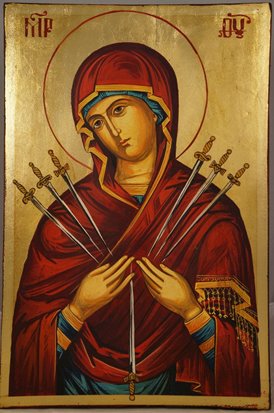 In Her wisdom, the Church has put together the calendar for the liturgical year in such a way that a number of feasts are symbolically related. For example, the recently celebrated Nativity of the Blessed Virgin Mary on September 8 is exactly nine months after the Feast of the Immaculate Conception on December 8. Similarly, the Feast of the Annunciation is nine months prior to Christmas.
In Her wisdom, the Church has put together the calendar for the liturgical year in such a way that a number of feasts are symbolically related. For example, the recently celebrated Nativity of the Blessed Virgin Mary on September 8 is exactly nine months after the Feast of the Immaculate Conception on December 8. Similarly, the Feast of the Annunciation is nine months prior to Christmas.
The feasts of the mother-son duo of St. Monica and St. Augustine are fittingly celebrated one after the other on August 27 and 28 so as to remind the faithful that it was through the many intercessory prayers of Monica that her wayward son, after leading a life of sensual excess, turned in his adulthood to Christ. And in a similar fashion, two feasts this week are set side-by-side to remind us of their relationship as well as the unity of the two people involved.
On Monday the Church celebrated the Feast of the Exaltation of the Holy Cross and on the next day the Memorial of Our Lady of Sorrows. The traditional Seven Dolors, or Sorrows, of Mary are all linked, in one way or another, with the Passion and Death of Her Son and so placing these feasts together reminds us of the personal nature of the Paschal Mystery as well as the role of Mary in the story of Salvation History.
As is so often the case, the Byzantine East, through the gift of iconography, can cast a gentle yet radiant light on the importance of this feast. The image of the Theotokos or “God bearer” is common in Eastern iconography, and she will assume many roles in these paintings: Our Lady of Perpetual Help, Merciful Mother of God, etc. In fact, there is an 18th Century Russian chart that depicts 132 different renditions of the Theotokos.
The image associated with Our Lady of Sorrows is commonly known as Our Lady Who Softens Evil Hearts. In renditions of this icon the Blessed Mother is pierced by seven swords, each representing one of the Seven Sorrows traditionally associated with her life as the Theotokos. All of the swords are piercing her heart – three through each of the shoulders and a final one from below. The symbolism is directly related to the prophecy delivered to Mary by Simeon at the Feast of the Presentation: “Behold, this child is destined for the fall and rise of many in Israel, and to be a sign that will be contradicted (and you yourself a sword will pierce) so that the thoughts of many hearts may be revealed.”
Here Simeon tells the Blessed Mother that there is a direct link between the mission of Jesus, her sorrow and the hearts of the multitude. Within this context, the meaning of the Byzantine icon of the Mother who softens evil hearts is made manifest. Given the words of the elderly prophet, the seven swords of the icon represent not only the Seven Sorrows of Mary, but also the seven deadly sins abiding in the hearts of all humankind.
These hearts, burdened with sin, are revealed to Mary, and each is a constituent part of the blades that wound the Theotokos to the core. She knows, better than anyone, that these sins were and are the cause of the Passion and Death of her Son. Yet, in this icon, both the position of her hands and the look in her eyes tell the viewer to come to her for comfort and healing. She is adorned in blue, symbolic of her role as Theotokos, but she is also draped in a cloak of red – the color of the heart, love and the Resurrection – showing that she is also the bearer of love to all of her sinful children.
Mary’s call is universal, it extends to all of her children, no matter which or how many swords they have wielded. Our response to that call is simple, though not easy: a humble softening of the evil in our hearts. In this softening we not only become closer to Mary, but to her Son, and to His Cross, which is our only hope.
A.M.D.G.